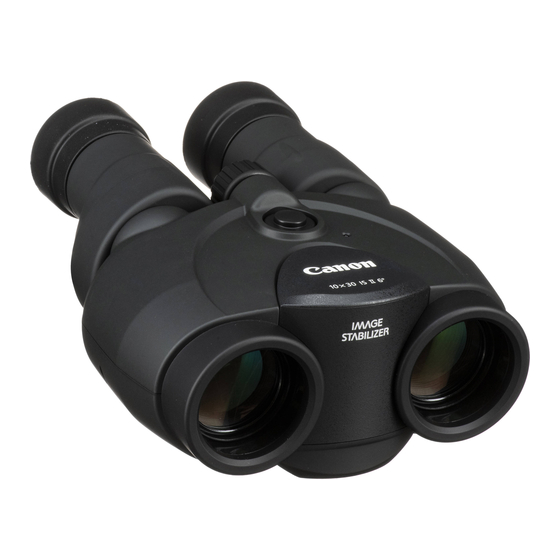Canon 10x30 IS II Manuel - Page 11
Parcourez en ligne ou téléchargez le pdf Manuel pour {nom_de_la_catégorie} Canon 10x30 IS II. Canon 10x30 IS II 25 pages. Technology guide
Également pour Canon 10x30 IS II : Brochure & Specs (8 pages), Brochure & Specs (8 pages), Manuel de l'utilisateur (2 pages), Manuel d'instructions (13 pages)

3) Twilight Coefficient
Watching a bird from a distance at night, you would use a 300
mm f/2.8 instead of a 50 mm f/1.4 lens, even if the brightness
were cut in half. The amount of gradation which the human
eyes can see is very large, and with experience, will be able
to distinguish between the colors. In this way, although the
eyes may be weaker when bright, the higher the magnification
(resolving power), the more detail the eyes will be able to
distinguish. A simple calculation rule:
Twilight Coefficient =
For example, if you compare the brightest binoculars for general
use, those of 7x50 (exit pupil: 7.1 mm) and 12x36 (exit pupil:
3.0 mm), the binoculars of 7x50 are brighter. But with the
twilight coefficient:
As a result, using 12x36 binoculars at night will provide more
detail.
Brightness and Lens Reflection
Even with binoculars with the same exit pupil, the brightness
may not always be the same. This is due to the amount of
light reflected by the lens. With uncoated lenses, about 8% of
incident light is reflected. The more light is reflected, the lower
the brightness of the images will be, in addition to a decrease in
image quality.In order
to prevent the incident
light from being
reflected, Canon uses a
"super spectra" coating,
which has been highly
praised for its efficacy
with Canon' s EF lenses.
Canon also coats the
prisms as well to ensure
bright and clear images.
Magnification x Available Aperture of Objective Lens
(the brightness is limited to a certain point)
7x50=18.7
12x36=20.8
Left: lens not coated. Right: lens coated. The lens
on the left looks white because light is reflected.
Exit Pupil/Available Aperture of Objective
Lens/Twilight Coefficient
